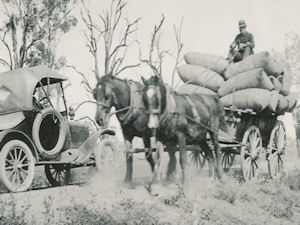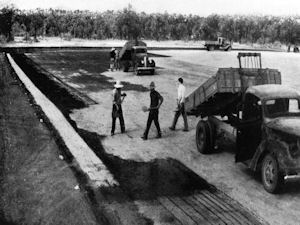History of Queensland's roads
Heritage Centre is closed
Please note the Heritage Centre is currently closed until further notice.
- 1800 to the 1900s
- The 1920s
- The 1930s
- The 1940s
- The 1950s to the 1960s
- The 1970s to the 1990s
- The 2000s
Our modern transport network is often taken for granted.
Roads and railway lines criss-cross our nation and with world-wide air travel at our finger tips, people can go just about anywhere in record time and air-conditioned comfort. Ships bring our domestic, industrial and luxury needs into ports every day of the week while around the clock, trucks deliver them to our malls, shops and doorsteps. Little thought is given to this sophisticated system but over the past century or so it has evolved from humble beginnings.
Many of today’s roads follow the pathways of Australia’s Aboriginal people. Pathways that were used and expanded on by convict labourers, pioneer settlers and early explorers such as Ludwig Leichhardt.
1800 to the 1900s

Following the path forged by explorer Alan Cunningham in 1827, Patrick Leslie and convict Peter Murphy explored the Darling Downs region in 1840. Moreton Bay’s penal settlement was disbanded in 1842, opening up the area to free settlement. Brisbane grew and road construction—such as it was—became a serious concern.
In 1859, Queensland was declared a new colony. Construction on the railway system began in 1863 and it soon became the major means of moving goods and people. The fledgling government left responsibility for roads to local authorities and communities so it could concentrate on developing rail infrastructure to deal with growing transport needs.
The early 1900s saw the arrival of motorised road transport and with it, growing competition for the railway. Cars and trucks provided a direct and immediate form of transport never seen before and their popularity quickly took hold. The government was placed under mounting pressure to improve roads, not only by the new 'pleasure' drivers, but also by farmers who realised this new mode of transport could have financial benefits by getting goods quickly and safely to railheads.
The 1920s

In 1920, the Queensland Government set up the Main Roads Board with John R. Kemp as the first Commissioner. Commonwealth, state and territory governments were eager to encourage economic development as well as overcome financial and technical deficiencies that prevented a cohesive road network. Roads were recognised as strategically important to developing Australia's wide open spaces—linking city with country across the nation.
Most roads were constructed to feed into the rail network and with financial and logistical constraints placed upon them; the Main Roads Board's early work prioritised the improvement of these roads. Under the Main Roads Act 1920 a road could only be gazetted as a ‘main road’ under certain conditions. Responsibility for local roads was retained by local councils, allowing the Main Roads Board to focus on 3 statewide priorities—developing and constructing:
- major roads connecting towns not already connected by rail
- secondary roads linking farming areas to the rail network
- roads to open new areas of Crown land to closer settlement.
 By the end of June 1922, the Main Roads Board had developed a plan of roads it believed should become main roads and the future backbone of a statewide network.
By the end of June 1922, the Main Roads Board had developed a plan of roads it believed should become main roads and the future backbone of a statewide network.
The 1930s
During the Great Depression, Main Roads played a significant role in unemployment relief. During this time projects included Somerset Dam, buildings at the University of Queensland St Lucia campus and the Story Bridge. To many the Story Bridge symbolised triumph over adversity—a sign for a positive future.
The popularity of motor vehicles continued to rise and by 1937 private registrations reached 111,000. Construction of main roads became a priority and the highway system began to take shape.

World War II brought about many changes and Main Roads' contributed towards infrastructure for the war effort. The Main Roads Board, renamed the Main Roads Commission, took on a range of defence projects including the construction of:
- military camps
- aerodromes
- fortifications
- fuel storage
- tanks
- firing ranges
- parade grounds
- docks
- jetties
- additional roads.
The 1940s
The Department of Transport was created in 1947 to deal with the rapid growth in the number of motor vehicles and passenger and freight transport. The functions of the department originally included:
- determining traffic routes and transport rules
- public transport timetables and ticket pricing
- motor vehicle inspections
- vehicle registration
- licensing
- developing transport infrastructure
- electrification of rail transport.
Over the years, the department took on wider responsibilities, from managing transport infrastructure to running driving safety campaigns.
The 1950s to the 1960s

Motor vehicle registration continued to rise and with many roads unable able to cope with this increase in road usage, priority was given to road widening and with it increasing road safety.
In the 1960s Main Roads began to open offices in regions and districts around Queensland. The offices had more authority and responsibility over their local main roads. More training was provided for staff and a road plan was developed.
In July 1963 the 20-year Road Plan for Queensland was launched. Offering a vision for the future and guidance for constructing a cohesive road network, the plan simplified road classification identifying state highways, main roads, secondary roads and developmental roads. Providing an integrated road network, the plan ensured no town was too far from a declared main road thus encouraging further social, economic and rural development.
The 1970s to the 1990s
As part of the road plan, the Beef Roads Scheme was developed. Designed to increase beef production and export income, this joint Commonwealth and state project saw the construction of road networks in the remote north. Built through raw bush or upgraded from rough tracks, by 1974 over 3980km of roads had been completed to transport livestock from isolated properties to railheads and ports by road train.
The Developmental Road Scheme—like the Beef Roads Scheme— encouraged investment in the remote, resource-rich areas of western Queensland. Surveyors and road workers endured isolation, heat, dust and torrential rain but their efforts brought great social and economic benefits to remote Queensland communities.
With significant growth already occurring in Queensland, by the 1970s further planning and infrastructure expansion was necessary. Slowly, rural roads were widened and converted from dirt to bitumen.
As Brisbane grew, construction on the South East Freeway and Riverside Expressway began. Almost 20 years later the Gateway Bridge (now 1 of the Sir Leo Hielscher bridges) and arterial roads were built. From the 1970s to 1990s, methods of road design and construction evolved to more sophisticated methods. To cope with more traffic, roads became bigger and the machinery to build them increased in size also.
The 2000s
 In March 2009 Queensland Transport and the Department of Main Roads joined to form the Department of Transport and Main Roads.
In March 2009 Queensland Transport and the Department of Main Roads joined to form the Department of Transport and Main Roads.
The department’s current challenge is to keep up with the population growth. Our road transport system continues to modernise—safety, comfort and quicker travel times are important factors for today's designers. And, of course, a major responsibility is to maintain the infrastructure we already have.
The department is responsible for the state’s largest built community asset—the Queensland state-controlled road network—and employs over 8,000 full time workers. The asset—worth $46.9 billion—is made up of over 33,000km of roads and carries more than 85% of the state's traffic.
We've come along way since 1920 and who knows where the future will take us, but right now Transport and Main Roads continues on a road well travelled.
- Last updated 19 October 2023

